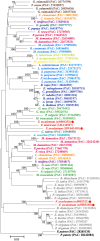Assembly of the draft genome of buckwheat and its applications in identifying agronomically useful genes
- PMID: 27037832
- PMCID: PMC4909311
- DOI: 10.1093/dnares/dsw012
Assembly of the draft genome of buckwheat and its applications in identifying agronomically useful genes
Abstract
Buckwheat (Fagopyrum esculentum Moench; 2n = 2x = 16) is a nutritionally dense annual crop widely grown in temperate zones. To accelerate molecular breeding programmes of this important crop, we generated a draft assembly of the buckwheat genome using short reads obtained by next-generation sequencing (NGS), and constructed the Buckwheat Genome DataBase. After assembling short reads, we determined 387,594 scaffolds as the draft genome sequence (FES_r1.0). The total length of FES_r1.0 was 1,177,687,305 bp, and the N50 of the scaffolds was 25,109 bp. Gene prediction analysis revealed 286,768 coding sequences (CDSs; FES_r1.0_cds) including those related to transposable elements. The total length of FES_r1.0_cds was 212,917,911 bp, and the N50 was 1,101 bp. Of these, the functions of 35,816 CDSs excluding those for transposable elements were annotated by BLAST analysis. To demonstrate the utility of the database, we conducted several test analyses using BLAST and keyword searches. Furthermore, we used the draft genome as a reference sequence for NGS-based markers, and successfully identified novel candidate genes controlling heteromorphic self-incompatibility of buckwheat. The database and draft genome sequence provide a valuable resource that can be used in efforts to develop buckwheat cultivars with superior agronomic traits.
Keywords: GBS marker; buckwheat; database usage; draft sequence; heteromorphic self-incompatibility.
© The Author 2016. Published by Oxford University Press on behalf of Kazusa DNA Research Institute.
Figures




References
-
- Kim S., Park M., Yeom S-I. et al. . 2014, Genome sequence of the hot pepper provides insights into the evolution of pungency in Capsicum species, Nat. Genet., 46, 270–8. - PubMed
-
- Zhang G., Liu X., Quan Z. et al. . 2012, Genome sequence of foxtail millet (Setaria italica) provides insights into grass evolution and biofuel potential, Nat. Biotechnol., 30, 549–54. - PubMed
-
- Varshney R.K., Chen W., Li Y. et al. . 2012, Draft genome sequence of pigeonpea (Cajanus cajan), an orphan legume crop of resource-poor farmers, Nat. Biotechnol., 30, 83–9. - PubMed
-
- Giménez-Bastida J.A., Zieliński H.. 2015, Buckwheat as a functional food and its effects on health, J. Agric. Food Chem., 63, 7896–913. - PubMed
MeSH terms
Substances
LinkOut - more resources
Full Text Sources
Other Literature Sources
Molecular Biology Databases
Research Materials
Miscellaneous

